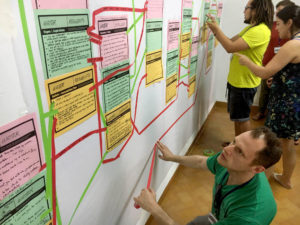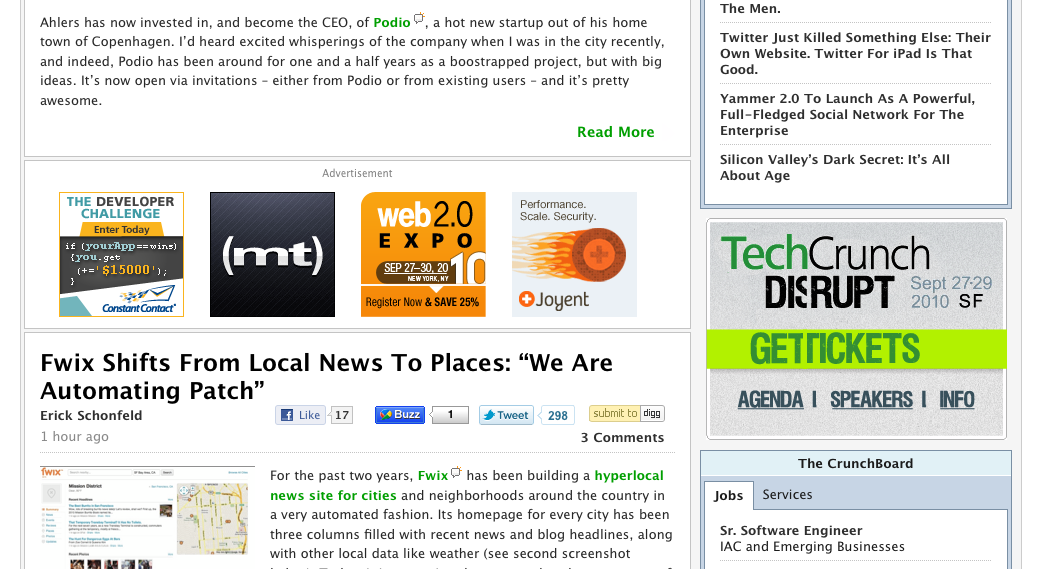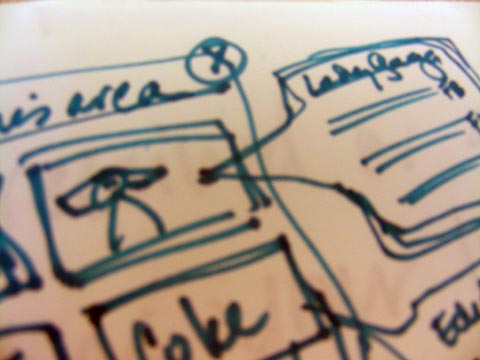Category: Design Thinking
The election last November shook me, as it did so many people. I became fascinated with understanding these “other” voters so that I could see, through their eyes, these issues that seemed so black and white to me. I started to see the complexities in the challenges of American identity, job creation, political accountability. I began to search for books that might explain some of it, and there were a few that helped to describe the problem, but of course, most academics don’t propose solutions. That’s what designers do. But these topics are so much more complicated than the bounded problems we typically work on when there is a client, a set amount of time, a set amount of money and an expected outcome.
What would it mean to work on a design challenge that could take 100 years to solve? 50 years, ok, 20 years, if that helps it feel more plausible.

It turns out that Terry Irwin, the head of the School of Design at Carnegie Mellon is exploring this right now. She has instigated a new practice in Design called Transition Design, which comes out of her Ph.D. research with ecologist Gideon Kossoff, and philosopher turned design professor, Cameron Tonkinwise. The three of them propose that in response to the failure of Ecology and Sustainability to sufficient change behavior and improve attitudes toward more long-term thinking about the earth, Design may be able to help. But only with new tools to handle the complexity, new mindsets to deal with such long-term challenges and new training in systems of change.
I have to admit that I never personally connected with the Green Design movement, so I was surprised to find myself excited about Transition Design. But I think it is because Transition Design can be used to tackle any number of societal issues we face today, and it approaches with a great deal of empathy and a curiosity about the causes and mindsets that are at the root of the problem.
I was invited to attend a 5-day course in Spain with Terry, Gideon, and Cameron. The course had an incredible diversity of attendees: some service designers, some design professors but also community organizers and NGO workers– from all over the world. The attitude these three leaders take is that this discipline of design is just beginning, the same “problem worrying” they apply to Transition challenges, they apply to the development of the tools and methods themselves. It is all work in progress, and they invite us all to try it out and build on what is there.
We believe that rich stories and visual frameworks help to establish a new understanding of what is meaningful to people. This foundation helps researchers, designers, engineers and business leaders develop strategies and concepts together, based on a new, shared perspective.
1. Seek to be surprised
Relax into the trusted approach. Absorb everything because you don’t know where the solution will be. Resist narrowing too quickly.
2. Collaborate to learn and teach
Bring stakeholders into the field—and through synthesis-— to build a shared understanding of the opportunity well before the final deliverable.
3. Form a point of view
Innovation research is more of an art than a science. Curate a compelling call to action rather than reporting on everything observed.
4. Visualize relationships
Frameworks are powerful tools that can highlight important aspects of your story. They can be used again and again by stakeholders.
5. Focus on the elements of a good idea
Most organizations don’t suffer from a lack of ideas, they struggle with a lack of focus or a strong reason to pursue the right ideas.
Our goal is to establish a shared understanding of the opportunity area, then we can identify the elements of successful concepts. We generate the solutions together, with our client’s in-house expertise.
Helen Walters writes, once again, about how Design Thinking isn’t the magic bullet that some of us like to think it is, in a FastCo post. I found this paragraph helpful in articulating the value proposition of Participatory Innovation:
For designers to have strategic impact, they need to work with managers to ensure that the business elements of a project are being catered to, too. That might not play to the innate strengths of designers, but it’s vital for leaders to figure out ways for everyone to get along so that innovation can be a team sport. Otherwise, we’ll be left with bizarre stories such as the one that ran recently in The New York Times, with a Smart Design director arguing that the Flip camera was, in fact, just about perfect. Just not so perfect that Cisco didn’t decide to discontinue making the product. Executives don’t always make the right decisions, of course, and perhaps Cisco management did make the wrong call in this instance. But proclaiming that smartphones had no bearing on that discussion and arguing that all of the design decisions were correct smacks of hubris and myopia. Design doesn’t — shouldn’t — live in a bubble and designers need to bridge the divide between their world and business, not just lob ideas over the fence and hope for the best. As it stands, it takes a particular type of person who can span those two worlds. Those are the must-hire employees of the future.
Participatory Design acknowledges that we, as design researchers, are not seeking truth. What we gain from our interactions with participants is biased toward the questions we need to answer. The ideas that spark innovation and that are most inspiring to us as people who are intending to solve a problem—can come from many places.
With that in mind, Brendon Clark inspired me with the ways in which he has been exploring the boundaries of how much control he can give to others when he works with users and stakeholders in the field. Yesterday, in a chat with Brendon, a great influence of Participatory Design thinking for me, I realized myself how little control I give to those around me. He asked why.
“I… am trying to preserve the accuracy.”
Yet I have always acknowledged that the purpose of my approach is inspiration. When people ask me how I can stuffy only 6 people, I tell them that it only takes one clarifying story to change everything.
If I gave up some control to the designers and product managers in the field with me—to allow them to pursue the topics of the conversation that are most interesting—mightn’t we all be more inspired?
And the Participatory Design movement in Scandinavian, which I admire so much, has always been about bringing the user into the conversation as a equal participant. Easier heard than acted upon, apparently.
I see now how I tend to keep users in the dark during my field sessions—trying not to bias them by telling them what I want to know, or what I find most interesting. I remain neutral in the conversation– open and supportive– but still neutral, holding my card sort close to my chest, so to speak.
Brendon has been studying and writing about Performance as a way to put participants at the center of the conversation for innovation and design. He began his work, at the intersection of Anthropology and Participatory Design, with a focus on users and is now expanding his work to include stakeholders as participants as well. He says, “When you give people a stage, they naturally perform.” He sees our role as researchers as the people who create the stage.
So many product research projects focus on influencing a decision, for which the researcher provides very specific insights about a specific portion of the overall problem.The beauty of Participatory Design projects is that the focus in not only on the initial task-at-hand that needs to be solved by the group, but also that the unstated goal becomes raising the knowledge of the people in the room.
When engaging in formative, strategic research for my product teams, and by engaging them throughout the process, my goal is to inform my stakeholders about a broader, more holistic context of use.
I hadn’t thought about this particularly, until a design director at work said to my director, “I want to work with you. But my people can’t focus on anything but research that helps them design what they are working on right now.” [Read into that “can’t” what you will] His meaning was that I can’t spend time sharing insights with the designers that don’t directly answer questions about this widget or that widget. Very disappointing. Especially when I’ve developed good relationships with the Product Managers, Marketing Managers and Engineers by sharing stories and insights about user experiences that helps to raise there OVERALL understanding of how people use communication tools.
My purpose for this kind of sharing of insights is mainly driven by my belief that I am not at MOST of the meetings where decisions are made– if they are even made in meetings. I also can’t research every little question that comes up, “Should this button go here or here?” “Do people share photos or quotes more often?” Therefore I need to arm the decision makers with an empathy and understanding of how different users make choices, so that EVERY decision they make is a bit more informed by real end-users.
from Phsyics Web
“The Wisdom of Crowds” seems to be a sound idea, one many people get behind. But beyond the obvious application to user generated content, James Surowiecki runs into trouble trying to help businesses understand how to apply this principle in practice.
But I am enjoying hypothesizing that Roberto Verganti would agree that both he and Mr. Crowd are suggesting that good ideas (smart, accurate ideas in Surowiecki’s case, Design-Driven Innovation in Verganti’s case) comes from choosing the a diverse crowd and collaborating on ideas with them.
“The Wisdom of Crowds” describes the necessity of “cognitive diversity” to aggregate ideas, in fact, it is detrimental to continue to collaborate with a group of people who all think the same way about a problem. When you embrace the conflict that arises when a group of people with different perspectives hammer on a problem, better decisions result.
In “Crowds” the synthesis of ideas happens out in the open– the crowd does the work of finding the patterns and “truth” within the topic. In Verganti’s inspiration networks the synthesis may happen within the designer’s head as she or he aggregates multiple points of inspiration from diverse collaborators. But both emphasize the importance of reaching out beyond our own environments to find inspiration in new perspectives.
In the Carnegie Mellon Design program we were taught that Designers are experts in process, rather than topics. The pride of a CMU designer is that we can design “anything.” That works pretty well if you work in a consultancy, where everyone is expected to switch topics every few months, and enjoy it.
But when you work in-house, the expectations for your domain knowledge are much higher. I work for an internet company, and it is natural for people to expect me to know a great deal about technology. But I don’t. I know a great deal about people and how they behave and how they express themselves. And I know how to learn more about that. And I know how to get people to share their thoughts with me in a way that answers questions that are very difficult to answer.
But it erodes my credibility when I don’t know the latest TechCrunch opinion. So, of course, I try to read more blogs and articles. I try to use the latest apps and services. I have a twitter account: hillarydesres.
But in reality, I’m never going to spend all of my free time keeping up on the latest technology. But I’ve realized that through consistent collaboration with teammates, I learn far more than I would on my own. When I need to know the latest technology– or the latest anthropological theories– I know who to ask. I think of it as outsourcing my knowledge. I have all the knowledge I need– I just keep it stored in other people’s brains.
After working for several years at a design and innovation firm, I’d grown to rely on Designers for creative problem solving… sort of thinking of myself as the person who leads the framing of the interesting, relevant questions and Designers as the ones who lead the elegant solution-finding. But in my new position I’ve been without Designers on my team. But because I position myself as a Design Researcher, I wanted to deliver insights that had solutions, at least the beginning of solutions, attached to them.
That’s when I realized that this was a chance to rely on the kindness of teammates. And they’d probably enjoy it along the way. I turned each of my findings presentations into brainstorming sessions– presenting compelling user stories alongside opportunity areas. I asked questions like “Imagine that 10 years from now we are wildly successful as _______. What would that experience be like?” And asked engineers, product and marketing managers to grab a sharpie and some half-sheets of paper and tell me what I didn’t already know.
It has been a great way to understand what my brilliant teammates know about the opportunity areas– and they have diverse perspectives. It’s also been a great way to learn what is most surprising and inspiring to the teams. Some insights they nod their heads, sometimes they even say, “we’re already working on that.” But other insights spark great conversations, light bulbs pop up around the room. Those are the topics I dig deeper into.
The best part is that I did this before delivering my final report. So now, as I craft that massive presentation, I know what my stakeholders care about. I know more about it than I did before. And I have funny little sketches to illustrate many of the important points.
Insights must incite. If a fantastic insight falls in the forest and no one hears it, is it still valuable?
What Design brings to research to make it more suitable for innovation is not better research methods.
The creative-thinking and rule-breaking of design does little to improve the reliability of research… what it does bring is a new perspective on the problem:
- Seek more interesting users (extreme people with strong ideas and opinions)
- Ask more surprising questions (to learn the unexpected)
- Look between the lines (discover the latent needs that describe opportunity areas)
- Focus on the future (forget describing what is currently happen, predict what logically comes next)
- Focus on what is actionable (forget describing the entire experience, illuminate what has potential)
- Deliver findings in a compelling way (use visuals to make insights more accessible)
- Design the experience of receiving the insights (no more PowerPoint– get your listeners involved)
I have been practicing Design Research for nearly ten years now, in various contexts. And a recent conference hosted by DMI helped me take a critical look at how I can improve my practice.
Roger Martin has contributed foundational work to the conversation of what Design Thinking is and why it is valuable. From his definition I am able to see that Design contributes two distinctly different benefits to problem-solving:
1. A new way of looking at the problem
2. Creative tools for finding solutions
To me, this breaks down into two steps– though for many people these may happen instantaneously. When I think about my own current work, conducting user-centered research to help inform the future of Communications products, I realize that I haven’t been pushing hard enough on the second point. I enjoy the process of developing insights. Insights are compelling and exciting, and it’s rewarding to read between the lines and discover new opportunities. But to fully participate in Design Thinking, I need to deliver insights together with possible solutions.
In my current project, I am not partnered with a Designer to help me find creative solutions. I choose not to look at this as a barrier, but as an opportunity to engage others in my mission to find new solutions. I see now, after listening to a series of Design Thinkers at the “Re-Thinking Design” conference, that I need to turn my glossy presentation of exciting insights into a working session that engages different teams in helping me to shape the final part of my presentation– together we can propose solutions that make the insights more compelling and real.




